We booked our trip on Cruise West, a small-ship cruise company with a good reputation and an excellent recommendation from a friend. We wanted the small ship experience because they are focused more on things outside the ship (wildlife, scenery, and local people) and not on ship-based activities such as casinos, shopping, swimming pools, etc. Plus, a small ship offers a more intimate experience and can go places where the large ships can't, into smaller bays and coves, for example, and to towns that don't have the dock facilities for the big ships. We chose wisely and heartily recommend Cruise West for anyone looking for an Alaska experience.
Our trip started with a 5-day land tour, shown in this map.
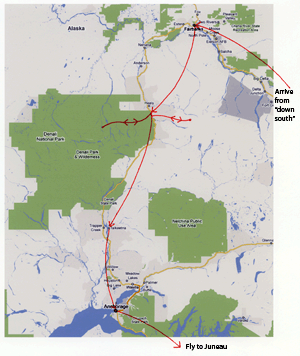
Then, we flew to Juneau to board the cruise ship, whose route is shown below.
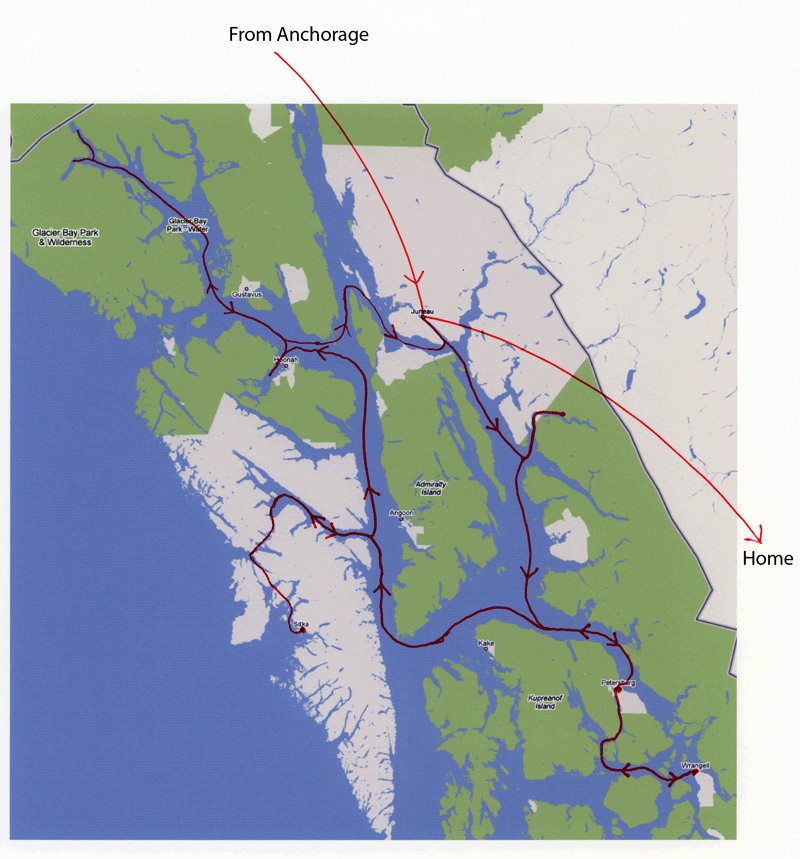
This page presents Peter's journal, written during the trip, along with some photos. At some point I will be posting a "photo blog" that has less talk and more photos, and I'll let you know.
Wed Aug 11
Our flights (Raleigh - Chicago - Anchorage - Fairbanks) went as well as one can expect. We checked in at Pike's Waterfront Lodge and tried to stay up "late" to reset our clocks. Alaska is 4 hours behind North Carolina so it was tough! Our room overlooked the Chena River and was very comfortable.
Thurs Aug 12
Because we came a day early, this day was our own. We got a lift to downtown Fairbanks and saw the very nice visitors center (great exhibits on the native people or Athabascans and an archway made of moose antlers, something you don't see every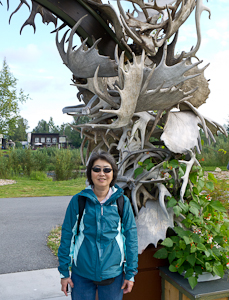 day!). The rest of downtown was pretty pitiful, as were the shops we found. Pioneer Village had a few things of interest, such as an old stern-wheel steamboat, detailed dioramas of historical Alaska settlements, an aviation museum, gold mining history, and a railroad museum.
day!). The rest of downtown was pretty pitiful, as were the shops we found. Pioneer Village had a few things of interest, such as an old stern-wheel steamboat, detailed dioramas of historical Alaska settlements, an aviation museum, gold mining history, and a railroad museum.
The Lodge has a surprisingly good breakfast buffet including corned beef hash. We were to find that biscuits with sausage gravy is a popular breakfast item in Alaska - I always thought of this as a southern tradition. The buffet included a good fruit selection including papaya (I am pretty sure that's what it was)!
The official tour began in the evening. We forewent the wine and cheese reception for a float on the Chena River. Very calm, no rapids, but we saw several beaver who slapped their tails at us, and visited Vicki, the owner of the raft outfit, at her electricity- 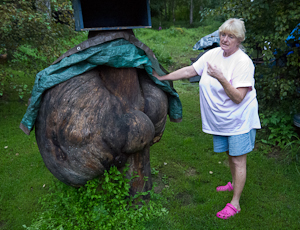 and water-less cabin where she lives year around. She showed us a giant burl (see photo), an odd tree outgrowth that is prized by woodworkers - plus, her quite fancy outhouse. We met her 170 pound Great Dane and learned some things about how many people in Alaska live "off the grid" and get along just fine. Fishing and hunting moose and caribou are important food sources for many people.
and water-less cabin where she lives year around. She showed us a giant burl (see photo), an odd tree outgrowth that is prized by woodworkers - plus, her quite fancy outhouse. We met her 170 pound Great Dane and learned some things about how many people in Alaska live "off the grid" and get along just fine. Fishing and hunting moose and caribou are important food sources for many people.
Fri Aug 13
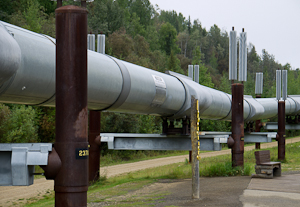 A brief stop along the Alaska pipeline was very informative. However you may feel about oil drilling, the pipeline is an impressive technological achievement, designed to withstand earthquakes and severe temperature changes. When oil was first pumped through the pipe, the pipeline length increased by over a mile due to expansion caused by the warm (~100 degrees) oil, and this was all planned for. In the photo, the fins on top of the support pillars are to dissipate heat from the oil, which otherwise would melt the permafrost (permanently frozen ground) and compromise the pipeline's support.
A brief stop along the Alaska pipeline was very informative. However you may feel about oil drilling, the pipeline is an impressive technological achievement, designed to withstand earthquakes and severe temperature changes. When oil was first pumped through the pipe, the pipeline length increased by over a mile due to expansion caused by the warm (~100 degrees) oil, and this was all planned for. In the photo, the fins on top of the support pillars are to dissipate heat from the oil, which otherwise would melt the permafrost (permanently frozen ground) and compromise the pipeline's support.
Warned off the river boat cruise (700 people!), we instead went to visit the home of Mary Shields, the first woman to complete the Iditarod dog sled race. We met her team of dogs, very well-behaved, and learned a lot about mushing, dog training, and life in the bush. Then the group, perhaps 16 people, were invited into her cabin (a real log 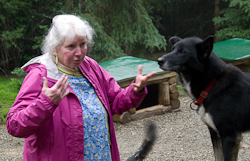 cabin) for cake and coffee and more talk about mushing. She told us how traditional sled dogs are "mutts" and are selected for smarts and strength because their main purpose was hauling freight. They are not purebred Huskies or Malamutes. Racing dogs, for the Iditarod, for example, are a lot smaller and are bred for speed. Mary thinks the Iditarod and some races have gotten too far away from the roots of mushing, emphasizing speed over everything else.
cabin) for cake and coffee and more talk about mushing. She told us how traditional sled dogs are "mutts" and are selected for smarts and strength because their main purpose was hauling freight. They are not purebred Huskies or Malamutes. Racing dogs, for the Iditarod, for example, are a lot smaller and are bred for speed. Mary thinks the Iditarod and some races have gotten too far away from the roots of mushing, emphasizing speed over everything else.
In the afternoon we boarded a "motor coach" (fancy bus) for the 2.5 hr drive to Denali. It was a pleasant drive with much lovely scenery. At the lodge just outside the park we had a pleasant if a bit cramped room overlooking the Nenana River. This is a glacial river and the water is gray from all the silt. It does not support any life because of the silt. It was about 40 yards wide at this location - it flows north and ends up joining another river which joins the Yukon and flows into the Bering Sea.
Interestingly, we had cell phone service almost everywhere in Alaska but phone only, no email or data services. This is thanks to Verizon, because people with Blackberries on AT&T had full service.
Sat Aug 14
A 5 AM rise to eat breakfast before boarding a bus (no motor coach here!) for the Tundra wilderness tour. Rather poor breakfast buffet, powdered eggs, undercooked bacon, very little fruit, extra charge to get orange juice (really!).
The tour was an 8 hour ride (round trip) into the park to a point about 30 miles from the mountain (Denali, aka Mt. McKinley). The naming of the mountain is itself an interesting story. President McKinley never visited Alaska, but he did support the gold standard as the basis for US currency over the silver standard, and because Alaska mines a lot of gold he was so honored. There is a widely supported movement to officially change the name to Denali, "The Great One" in the native language.
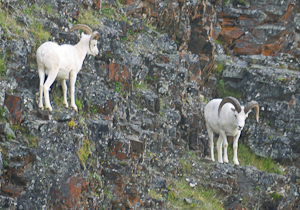 We had a lovely day with high clouds, quite a change from the very rainy July they had here. On the drive we saw a "grand slam," all 5 large mammals that are present: caribou, Dall sheep (lovely pure white animals with gracefully curving horns), wolves, and moose fairly close up, and a grizzly (brown bear) with cub at a distance. A wolf trotted right past the bus and we also saw a "rendezvous" where a pack's cubs stay while the adults hunt. We also saw a gyrfalcon (or it may have been a golden eagle, the guide was not sure). The sighting of the wolves was very fortunate because the park biologists estimate that there are only 60-70 adult wolves in the entire enormous expanse of the park.
We had a lovely day with high clouds, quite a change from the very rainy July they had here. On the drive we saw a "grand slam," all 5 large mammals that are present: caribou, Dall sheep (lovely pure white animals with gracefully curving horns), wolves, and moose fairly close up, and a grizzly (brown bear) with cub at a distance. A wolf trotted right past the bus and we also saw a "rendezvous" where a pack's cubs stay while the adults hunt. We also saw a gyrfalcon (or it may have been a golden eagle, the guide was not sure). The sighting of the wolves was very fortunate because the park biologists estimate that there are only 60-70 adult wolves in the entire enormous expanse of the park.
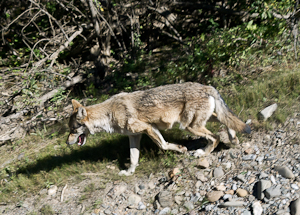
This area, and central Alaska in general, is very cold in the winter (the typical low is minus 50) and relatively dry. There is not very much snow, a few feet in an average winter, and the ecosystem is relatively sparse with a small number of animal and plant species and a relative scarcity of food. For example, the brown (grizzly) bears here are much smaller than those in south east Alaska because they don't have access to salmon.
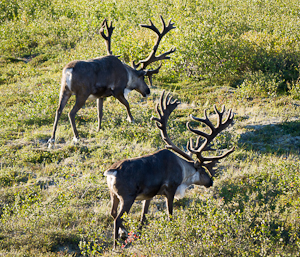
Caribou, called reindeer when domesticated, are beautiful creatures. Both males and females have antlers and the males' racks can become quite large. It turns out that Santa's reindeer are all female because only the females retain their antlers at that time of year.
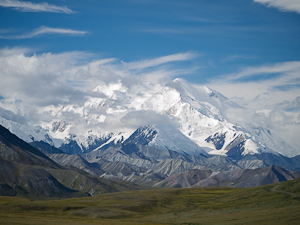 And, big treat, we had several clear views of the mountain. It is an amazing sight. The tallest mountain in North America, it rises to 20,320 feet. In a sense it is taller than Everest because Everest rises from a 17,000 foot plain, giving it an actual rise of about 12,000 feet, while Denali rises ~18,000 feet from a base at 2,000 feet. Covered with snow, it is a majestic sight. There were many wonderful photo opportunities but the bus rarely let us out so most photos had to be thru an open window.
And, big treat, we had several clear views of the mountain. It is an amazing sight. The tallest mountain in North America, it rises to 20,320 feet. In a sense it is taller than Everest because Everest rises from a 17,000 foot plain, giving it an actual rise of about 12,000 feet, while Denali rises ~18,000 feet from a base at 2,000 feet. Covered with snow, it is a majestic sight. There were many wonderful photo opportunities but the bus rarely let us out so most photos had to be thru an open window.
In the evening we took an "interpretive hike." A very nice and knowledgeable young guide took us (just us 2) up a mountain trail while explaining all about the plants and trees, native lore, trapping, etc. It was a strenuous walk but great fun. On the way back we stopped at a blueberry patch for a 15 minute snack. We also saw and tasted crow berries, pumpkin berries, and cranberries.
Sun Aug 15
 In the morning we went white water rafting on the Nenana River. We were dressed head-to-toe in dry suits, which were certainly needed as it turned out. Could not use the camera, unfortunately - this photo was taken by a staff member station on the bank as we went by. There were 4 rafts, each with a guide and 7-9 riders. We went thru class 3 and 4 rapids, it was great fun. After, we stayed in the "village," a collection of shops and restaurants about 10 miles from our lodge, and had WONDERFUL fish and chips (halibut) at a rustic little place called Alaska Fish and Chips. The shops did not turn up anything of interest beyond glass earrings for Maxine.
In the morning we went white water rafting on the Nenana River. We were dressed head-to-toe in dry suits, which were certainly needed as it turned out. Could not use the camera, unfortunately - this photo was taken by a staff member station on the bank as we went by. There were 4 rafts, each with a guide and 7-9 riders. We went thru class 3 and 4 rapids, it was great fun. After, we stayed in the "village," a collection of shops and restaurants about 10 miles from our lodge, and had WONDERFUL fish and chips (halibut) at a rustic little place called Alaska Fish and Chips. The shops did not turn up anything of interest beyond glass earrings for Maxine.
In the evening we had a very interesting lecture about wolves from a biologist. The focus was on why and how they study the wolves - darting, using radio collars, etc. There are currently about 60 wolves in the park (adults, this year's cubs are not yet counted) in 8-10 packs ranging in size from 2 to 14 wolves. Very few coyotes, it turns out, because the wolves actively kill them.
Finally there was a group dinner with the other Cruise West people. It was a lot of fun except for the foul food. We met Rick, a retired virologist from Johns Hopkins, and Jay, who told us more about woodworking tools than we really wanted to know, and a couple from Chapel Hill travelling with their grandson, among others.
Mon Aug 16
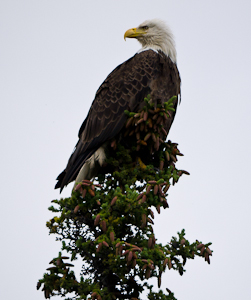 We started the day with the Denali Highway Tour. We were the only guests on the tour - our guide Kyle was very good. This highway is the "old“ road to Denali and comes in from the east. It was superseded by the new road from Anchorage a while back and is not much used except by locals. Calling it a highway requires some imagination - it is a dirt road and these days not well maintained. We drove perhaps 20 miles out and saw some gorgeous scenery, it was early AM and the clouds were still low on the mountains with the sun coming in and out. I got some
We started the day with the Denali Highway Tour. We were the only guests on the tour - our guide Kyle was very good. This highway is the "old“ road to Denali and comes in from the east. It was superseded by the new road from Anchorage a while back and is not much used except by locals. Calling it a highway requires some imagination - it is a dirt road and these days not well maintained. We drove perhaps 20 miles out and saw some gorgeous scenery, it was early AM and the clouds were still low on the mountains with the sun coming in and out. I got some 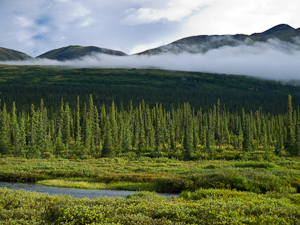 really good photos, I think. We saw a bald eagle and managed to get quite close. We also came across a lone male caribou on the road - it was trapped between our van and an oncoming pickup truck (both stopped) and did not want to pass either of us. Nor did it want to go back down the slope whence it came, and it could not seem to be able to find a way thru the thick brush on the up-slope side. So, it paced back and forth for a few minutes and Maxine got some very nice video. Finally it found a way to go up through the brush and was gone.
really good photos, I think. We saw a bald eagle and managed to get quite close. We also came across a lone male caribou on the road - it was trapped between our van and an oncoming pickup truck (both stopped) and did not want to pass either of us. Nor did it want to go back down the slope whence it came, and it could not seem to be able to find a way thru the thick brush on the up-slope side. So, it paced back and forth for a few minutes and Maxine got some very nice video. Finally it found a way to go up through the brush and was gone.
Back to the park entrance and the train depot where we caught the McKinley Explorer at noon for our ride to Anchorage (or actually to Talkeetna, a tiny town where we transferred to a coach). The 4.5 hour train ride was a real treat. The car had 2 levels. We rode on the top, 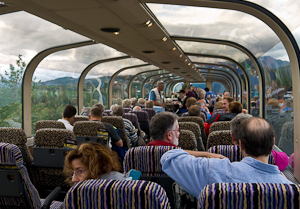 which was completely glassed-in and very comfortable, complete with a bar and bartender! We saw lots of wonderful scenery. The lower level was a white-tablecloth dining room where we had an excellent lunch of seafood chowder, reindeer chili (can't say it tasted much different from beef), and berry pie. This is the way to travel! The final leg, 2.5 hrs on a bus, was not very interesting, although we did get a brief glimpse of Sarah Palin's house and her new fence.
which was completely glassed-in and very comfortable, complete with a bar and bartender! We saw lots of wonderful scenery. The lower level was a white-tablecloth dining room where we had an excellent lunch of seafood chowder, reindeer chili (can't say it tasted much different from beef), and berry pie. This is the way to travel! The final leg, 2.5 hrs on a bus, was not very interesting, although we did get a brief glimpse of Sarah Palin's house and her new fence.
In Anchorage, we stayed at the Sheraton and had a very good dinner at The Brewhouse, one of the restaurants offered by the tour. Maxine had macadamia-encrusted salmon and I, feeling carnivorous, had a prime rib. We took bread pudding back to the room!
Tues Aug 17
We took a morning tour of the city that included the very interesting Anchorage Museum, then off to the airport for the flight to Juneau. We could see little on the flight because of clouds, although a few large mountains did poke thru. Downtown Juneau is fairly small and is mostly constrained by mountains to a strip along the shore of an inlet or bay. It is without road access from the outside, so it is ships and planes only. Unfortunately it has become a stop for the huge cruise ships so the waterfront has become a morass of cheap (and not so cheap) shops catering to the tourists. There is an unbelievable number of jewelry shops, but heaven help you if you want to get a coffee! Plus, the place is clogged with tourists much of the time. There were "only" 3 cruise ships here, sometimes there are as many as 7! Still, we had a decent salmon dinner after a walk in the rain.
Wed Aug 18
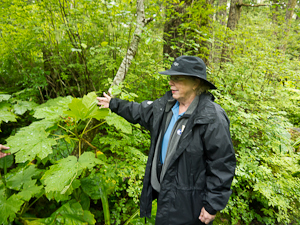 We had a very nice breakfast at a tiny cafe that was recommended by our bus driver - all home-baked breads and pastries and terrific coffee. Then off for a rainforest hike in, appropriately enough, a light rain. The forest is amazing, it is virgin and contains many huge spruce and hemlock trees towering over an amazingly fecund assortment of diverse plant life. Ferns, mushrooms, berries, mosses, bushes, every square inch has something growing, sometimes 2 or 3 layers deep. Our guide Bonnie knew every plant in the forest, I think. The walk included a stretch on a rocky beach.
We had a very nice breakfast at a tiny cafe that was recommended by our bus driver - all home-baked breads and pastries and terrific coffee. Then off for a rainforest hike in, appropriately enough, a light rain. The forest is amazing, it is virgin and contains many huge spruce and hemlock trees towering over an amazingly fecund assortment of diverse plant life. Ferns, mushrooms, berries, mosses, bushes, every square inch has something growing, sometimes 2 or 3 layers deep. Our guide Bonnie knew every plant in the forest, I think. The walk included a stretch on a rocky beach.
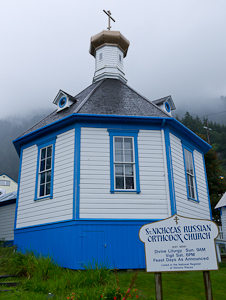 After a mediocre lunch at a Chinese/sushi place (I know, what were we expecting?) we visited an old Russian Orthodox church, Saint Nicholas, dating from 1894. This was after the US bought Alaska from Russia, but the Orthodox church has a long history in the area. In the period of Russian dominance (1741-1867) the Orthodox missionaries learned the local language, translated the Bible, and were not dismissive of native culture and customs, as were the Americal and British missionaries. As a result, a majority of ther Tlingit (indiginous people) embraced the Russian Orthodox faith and that devotion continues to this day. The church is a small wooden building painted blue and white, and it's octagonal.
After a mediocre lunch at a Chinese/sushi place (I know, what were we expecting?) we visited an old Russian Orthodox church, Saint Nicholas, dating from 1894. This was after the US bought Alaska from Russia, but the Orthodox church has a long history in the area. In the period of Russian dominance (1741-1867) the Orthodox missionaries learned the local language, translated the Bible, and were not dismissive of native culture and customs, as were the Americal and British missionaries. As a result, a majority of ther Tlingit (indiginous people) embraced the Russian Orthodox faith and that devotion continues to this day. The church is a small wooden building painted blue and white, and it's octagonal.
We then visited a salmon hatchery from which they release 125 million salmon a year - kings, sockeye, and chum. They have a fish ladder for the returning salmon from which eggs and milt are extracted. The fertilized eggs are hatched and the wee fish raised for 1-2 years before being released.
 After a fairly uninteresting story telling/dancing performance by a couple of locals, on to the ship, the Spirit Of Endeavour, named in honor of one of Captain James Cook's ships. The ship is 166 feet long, with 25 crew and a capacity of 110 passengers (we had 102 on this trip). It looks tiny next to the huge cruise ships, but is very comfortable inside. Our cabin is cozy, with an even cozier private bath, but then again we don't do much of anything there but sleep. It has a large window, on the second of four levels, perhaps 10 feet above the waterline. There's a lounge on this level, forward, and a dining room on level 1 that seats everyone at the same time. Level 3 is cabins that all open onto a wrap-around walkway, and level 4 is the bridge plus an open sundeck where they sometimes do barbecues.
After a fairly uninteresting story telling/dancing performance by a couple of locals, on to the ship, the Spirit Of Endeavour, named in honor of one of Captain James Cook's ships. The ship is 166 feet long, with 25 crew and a capacity of 110 passengers (we had 102 on this trip). It looks tiny next to the huge cruise ships, but is very comfortable inside. Our cabin is cozy, with an even cozier private bath, but then again we don't do much of anything there but sleep. It has a large window, on the second of four levels, perhaps 10 feet above the waterline. There's a lounge on this level, forward, and a dining room on level 1 that seats everyone at the same time. Level 3 is cabins that all open onto a wrap-around walkway, and level 4 is the bridge plus an open sundeck where they sometimes do barbecues.
If tonight's dinner is any indication, the eating will be grand. We had a spinach salad with hazelnuts, gorgonzola, a brioche crouton, and raspberry vinegairette followed by pasta with Dungeness crab, asparagus spears, and artichoke hearts. A drinking man could have a great (and expensive) time, they have a well-stocked bar and a very impressive wine list!
We saw a small pod of humpbacks after dinner but it was too dark for photos. We'll see more I am sure.
Thurs Aug 19
We motored through the night, south from Juneau along Stephan's Passage, and turned into Tracy Arm, a fjord extending east. I woke at 4:30 to see ghostly icebergs passing outside our cabin window in the dim light - immensely exciting! We sailed past increasing numbers of bergs for a couple of hours, ranging in size from very small to perhaps as big as a 2-car 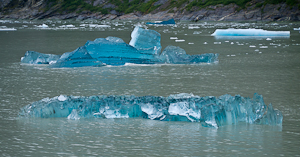 garage. Many had that lovely blue color that is unique to glacial ice. This color is the result of the ice being under huge pressures for a long time, which squeezes every bit of air out of the ice. The air diffuses the light, which is why most ice, including your ice cubes, is white and cloudy looking. Without the airt, the ice is clear and, if thick enough, blue.
garage. Many had that lovely blue color that is unique to glacial ice. This color is the result of the ice being under huge pressures for a long time, which squeezes every bit of air out of the ice. The air diffuses the light, which is why most ice, including your ice cubes, is white and cloudy looking. Without the airt, the ice is clear and, if thick enough, blue.
As we finished breakfast, the South Seward Glacier came into view, and I wolfed my food to get on deck! It is huge, the face is ~300 feet high and the frontage is perhaps 1/3 mile wide; the glacier marks the end of the fjord. We got within about 1/2 mile, the intervening sea was filled with bergs on which dozens of harbor seals rested (one with a pup). What a scene! The innumerable small pieces of ice are called "bergie bits." We saw some minor calving and took innumerable photos, 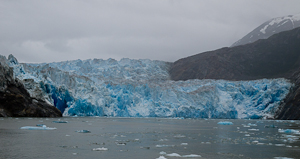 and also saw a few guillemot, a diving bird that looks like a football with wings. The male guillemot have bright orange feet and leg; the mating rutual consists of the male swimming up next to a female, lifting a leg out of the water, and wagging it at her. Ah, evolution!
and also saw a few guillemot, a diving bird that looks like a football with wings. The male guillemot have bright orange feet and leg; the mating rutual consists of the male swimming up next to a female, lifting a leg out of the water, and wagging it at her. Ah, evolution!
Eventually we turned and retraced our route out of the fjord, seeing four orcas along the way. We stopped after lunch for D.I.B. trips (a D.I.B. is a kind of Zodiac, a rigid inflatable boat that holds about a dozen people), we went out with a photographer (who had lots of tips useful for beginners) and got close to a large waterfall and several modest-sized bergs. Great fun!
We are now motoring further south in Stephan's Passage to Frederick Sound and on to Wrangell. At about 8:00, in Frederick Sound, we came upon a large pod of humpback whales - at least a dozen or more all around the boat, some close enough that we could hear their exhalations. Maxine got some nice video.
Fri Aug 20
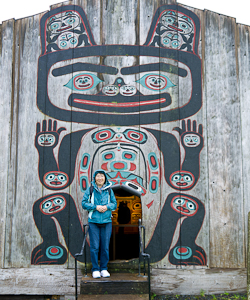 The ship pulled into Wrangell just after 6 AM. This is a small town of about 1600 people located on a large island near the mouth of the Stikine river. It is thankfully free of the large cruise ships and the attendant crowds and schlock stores. The town got its start during the Russian period when a fort was built to protect the fur trade. When the trade and Russian interest declined due to decreasing otter numbers, the British came in, and then in 1867 with the US purchase of Alaska the US took over. The town was an important waypoint during the Yukon gold rush until a better route to the Yukon was discovered (via Sitka) after which things declined. Presently the main activities are tourism, fishing, and boat repair. We toured the town (5 minutes!) and visited a recreation of a Tlingit clan house where we heard a presentation on Tlingit clans and history (although with limited details, apparently the Tlingit are traditionally rather secretive about details of their history and culture, considering them to be private family
The ship pulled into Wrangell just after 6 AM. This is a small town of about 1600 people located on a large island near the mouth of the Stikine river. It is thankfully free of the large cruise ships and the attendant crowds and schlock stores. The town got its start during the Russian period when a fort was built to protect the fur trade. When the trade and Russian interest declined due to decreasing otter numbers, the British came in, and then in 1867 with the US purchase of Alaska the US took over. The town was an important waypoint during the Yukon gold rush until a better route to the Yukon was discovered (via Sitka) after which things declined. Presently the main activities are tourism, fishing, and boat repair. We toured the town (5 minutes!) and visited a recreation of a Tlingit clan house where we heard a presentation on Tlingit clans and history (although with limited details, apparently the Tlingit are traditionally rather secretive about details of their history and culture, considering them to be private family 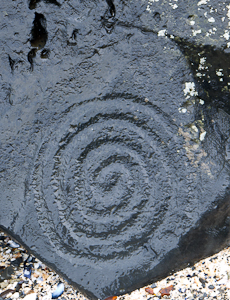 (clan) matters. Then we visited petroglyph beach where there are mysterious stone carvings of animals and faces. No one knows for sure who made these. It was a beautiful beach covered with boulders of beautiful black/dark gray rock on which the petroglyphs were carved. Finally we visited the local museum which has excellent exhibits on the area's history and wildlife.
(clan) matters. Then we visited petroglyph beach where there are mysterious stone carvings of animals and faces. No one knows for sure who made these. It was a beautiful beach covered with boulders of beautiful black/dark gray rock on which the petroglyphs were carved. Finally we visited the local museum which has excellent exhibits on the area's history and wildlife.
The afternoon was spent motoring toward Petersburg and passing thru Wrangell Narrows. This very narrow passage was dredged to greatly shorten the travel distance between various places. It can handle ships as large as ours but not much larger. It is twisty in some places and also occasionally so narrow that two ships like ours could not pass. Tonight we anchor just past the Narrows and continue to Petersburg tomorrow for an 8 AM arrival. We signed up for a jet boat trip to the LeConte glacier.
The food on this ship continues to astound. Breads and pastries are all fresh-baked by the on board pastry chef. Every meal includes a couple of specials and there is always local seafood. For example, last night's dinner offered sherry-onion soup, a Waldorf salad, and either halibut crusted with grated potatoes or braised beef shortribs, plus chicken and vegetarian dishes. Finally, local berry shortcake. Today's lunch special was fillet of sole with Dungeness crab risotto, and tonight we had black cod (sablefish) that was exceptionally moist and smooth. Great eating!
Sat Aug 21
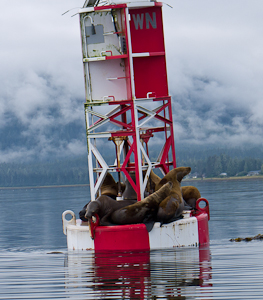 In Petersburg we docked at low tide, about 7:00 AM. We signed up for the LeConte Glacier tour. We disembarked at 8:00 from the 4th level because of the low tide (20 foot tides are typical). We were on a jet boat with a small group for the run to the glacier. We saw sea lions on the buoys as we left the harbor. After an interesting spell inside a rather soupy fog bank, we started coming across small bergs and then the glacier came into view. Dodging the bergs at high speed was fun, then as they got thicker we slowed down and threaded thru them, bumping some smaller ones aside. I can see why a prop would not last long here! The icebergs can be quite beautiful with an endless vartiety of shapes and often some of the blue color of compressed glacial ice.
In Petersburg we docked at low tide, about 7:00 AM. We signed up for the LeConte Glacier tour. We disembarked at 8:00 from the 4th level because of the low tide (20 foot tides are typical). We were on a jet boat with a small group for the run to the glacier. We saw sea lions on the buoys as we left the harbor. After an interesting spell inside a rather soupy fog bank, we started coming across small bergs and then the glacier came into view. Dodging the bergs at high speed was fun, then as they got thicker we slowed down and threaded thru them, bumping some smaller ones aside. I can see why a prop would not last long here! The icebergs can be quite beautiful with an endless vartiety of shapes and often some of the blue color of compressed glacial ice.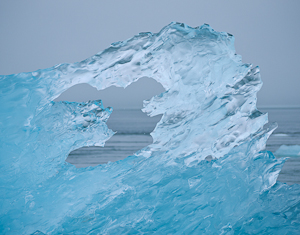
The glacier itself was astounding, 3/4 mile wide and 300 feet high at the terminus (with another 800 feet under the water). We saw a few minor ice falls and 2 large "calvings." Even when nothing visible is happening, the glacier often moans and groans and creaks with the most amazing low, resonant sounds. It is moving at several feet a day! Our guide was a local high school science teacher who studies the glacier each year with his students, and he knew a lot and was very good at explaining. Then a run back to town for a brief bus tour before reboarding, this time we had to climb up to deck 3 because the tide had come in quite a bit. After a nice fish and chips lunch we had the afternoon to ourselves.
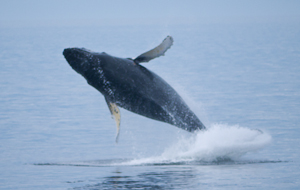 The afternoon brought us hoards of humpback whales in two large pods. It is amazing to see whale spouts all around the boat, with some blowing bubble nets and others breaching. We probably had three dozen in sight at a time.
The afternoon brought us hoards of humpback whales in two large pods. It is amazing to see whale spouts all around the boat, with some blowing bubble nets and others breaching. We probably had three dozen in sight at a time.
Sun Aug 22
We motored all night toward Sitka, which is quite a distance from Petersburg. As usual, we both slept like logs to the lullaby of diesel engines. Early morning brought a complete rainbow behind the ship. There are quite a few fishing boats working in this area, we have seen gill netters and purse seiners. The morning is ours until 10:00 when we arrive in Sitka after a brief, and our only, time in the open ocean (not really, as we will be in the Gulf of Sitka, but there will be no land between us and the ocean. We'll have until 2:00 to explore the town, then we have our sea kayaking adventure.
 We disembarked in Sitka and went to a traditional dance performance by a group of Tlinget youth - very nicely done with great costumes and much enthusiasm. Then off to a brief rainforest hike to see salmon spawning. These were pink salmon (most canned salmon is this kind) who have a two year life cycle. The stream, about 20 feet wide, was thick with them, literally a fish every 1-2 feet. Some were swimming upstream, others were spawning (females "digging" a nest in the gravel, etc). I have heard about this, but to actually see it really brought home the bounty and mystery of the salmon.
We disembarked in Sitka and went to a traditional dance performance by a group of Tlinget youth - very nicely done with great costumes and much enthusiasm. Then off to a brief rainforest hike to see salmon spawning. These were pink salmon (most canned salmon is this kind) who have a two year life cycle. The stream, about 20 feet wide, was thick with them, literally a fish every 1-2 feet. Some were swimming upstream, others were spawning (females "digging" a nest in the gravel, etc). I have heard about this, but to actually see it really brought home the bounty and mystery of the salmon.
 Next, sea kayaking! With much preparation, Maxine and I were installed in a two-seater and launched. I can't imagine getting into one of these things while it's in the water! It was hard enough when it was partly on land and we had help. My stiff joints and long legs are not a good match for kayaking! Anyway, we had a pleasant enough paddle (six people in three kayaks with a very nice guide), we saw purple and orange starfish, anemones, kelp, sea lions, eagles, and a marbled murrelet. By the end of two hours I was very uncomfortable and glad to get out of the kayak.
Next, sea kayaking! With much preparation, Maxine and I were installed in a two-seater and launched. I can't imagine getting into one of these things while it's in the water! It was hard enough when it was partly on land and we had help. My stiff joints and long legs are not a good match for kayaking! Anyway, we had a pleasant enough paddle (six people in three kayaks with a very nice guide), we saw purple and orange starfish, anemones, kelp, sea lions, eagles, and a marbled murrelet. By the end of two hours I was very uncomfortable and glad to get out of the kayak.
Mon Aug 23
Some more on the ship's routine. At 6:00 AM they put out a "continental" breakfast in the lounge - pastries, fruit, cereal, oatmeal, etc. Then at 7:00 a full breakfast is served in the dining room. Each day they will have two specials, for example smoked salmon potato pancakes, banana French toast, blueberry pancakes, Italian omelet. There's is also an assortment of standard items such as waffles, eggs, design-your-own omelet, etc. Food is not available throughout the day, aside from some fruit. Coffee and tea are always available, and I suspect the bar is always open! Lunch is at 12:30 and again there are two daily specials plus a standard menu (burgers, deli sandwiches). There is always at least one vegetarian dish available. At 5:30 we have social hour in the lounge with a variety of snacks ranging from the basic cheese and crackers to more elaborate items like deep fried cheese ravioli, broiled scallops, and crab cakes. Dinner at 6:30 also has a soup and special salad (plus house salad), three specials (one vegetarian), a different pasta dish each night, plus steak and chicken. There's a new dessert each night, plus a cheese and fruit plate, ice cream, sorbet.
OK, 'nuf about food. This morning is windy and drizzly. We stopped in a bay instead of going to Icy Straight because of gale force winds. We are doing DIB operations this morning, we go out at 10:00. I am not sure what we'll see but it's always interesting around here.
 It was a wet and windy DIB trip, with moderate rain and a 10-15 MPH wind. We were well protected in rain suits. We saw Dall's porpoises, marbled murrelets, and an eagle. Our guide pulled in a piece of kelp (left) and explained its complex relationship with sea urchins and sea otters. Good to get off the ship, it's sort of boring when we are anchored and the weather is nasty. Talking with others is nice, we've met many interesting folks including people from New Zealand and Australia, but I get my fill of that after a while.
It was a wet and windy DIB trip, with moderate rain and a 10-15 MPH wind. We were well protected in rain suits. We saw Dall's porpoises, marbled murrelets, and an eagle. Our guide pulled in a piece of kelp (left) and explained its complex relationship with sea urchins and sea otters. Good to get off the ship, it's sort of boring when we are anchored and the weather is nasty. Talking with others is nice, we've met many interesting folks including people from New Zealand and Australia, but I get my fill of that after a while.
Late this afternoon we arrived at the entrance to Glacier Bay and stopped briefly at the park station to take on Alice, a Tlinget interpreter, and Emily, a park ranger. This a requirement for a permit to go into the bay, part of the park service’s effort to promote appreciation of the area (they also require the large ships to close the casino!). Emily sat with us at dinner and showed a huge amount of knowledge about the area's history, geology, and biology. She also told us a lot about being a ranger, moving from park to park. She also plays the violin! Later, Alice gave a presentation about the people and their history. A few hundred years ago this Tlinget group lived on a large moraine in the valley that now holds Glacier Bay. This moraine had been there a long time as the glaciers were stable. Then the glaciers started to advance quickly and within a relatively short period of time they overran the entire area. Of course the Tlinget had to move elsewhere are build new homes. They hoped to move back if the ice retreated, which it did eventually (after several generations I believe) but the glacier had scraped away the moraine and the area was under water as it is today.
Tues Aug 24
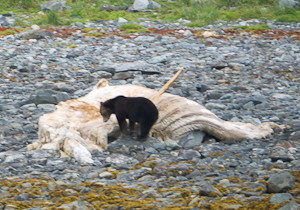 Believe it not, Maxine was up at 5:00 because she was so excited about seeing more glaciers. We were near the front of the Marjerie and Grand Pacific glaciers when we woke up, and we visited a few more tidal terminus glaciers over the morning. The mountains are full of hanging glaciers, the park and bay are aptly named. The glaciers don't seem to calve as often as the ones we saw earlier, and some of them are quite dirty. Emily showed us several brown bears gnawing on a whale carcass that washed up on shore a few months ago (photo); the ship was able to get within 50 yards of the shore for a great view. We saw mountain goats, too, rather far away.
Believe it not, Maxine was up at 5:00 because she was so excited about seeing more glaciers. We were near the front of the Marjerie and Grand Pacific glaciers when we woke up, and we visited a few more tidal terminus glaciers over the morning. The mountains are full of hanging glaciers, the park and bay are aptly named. The glaciers don't seem to calve as often as the ones we saw earlier, and some of them are quite dirty. Emily showed us several brown bears gnawing on a whale carcass that washed up on shore a few months ago (photo); the ship was able to get within 50 yards of the shore for a great view. We saw mountain goats, too, rather far away.
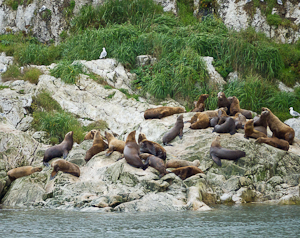 In the afternoon we circled South Marble Island, which is a small island perhaps 10 acres in size with mostly rocky cliff shorelines. It is home to hundreds of Stellar sea lions who were strewn all over the beaches and rocks, and sometimes set up a very amusing chorus of grunts and roars as they bickered and maneuvered for a spot on the rocks. There were lots of birds, too, glaucous seagulls, pelagic cormorants, tufted puffins (photo below), horned puffins, black legged kittiwakes, and maybe a distant white owl.
In the afternoon we circled South Marble Island, which is a small island perhaps 10 acres in size with mostly rocky cliff shorelines. It is home to hundreds of Stellar sea lions who were strewn all over the beaches and rocks, and sometimes set up a very amusing chorus of grunts and roars as they bickered and maneuvered for a spot on the rocks. There were lots of birds, too, glaucous seagulls, pelagic cormorants, tufted puffins (photo below), horned puffins, black legged kittiwakes, and maybe a distant white owl.
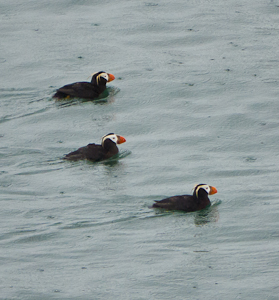 Before being dropped off at the ranger station, Alice performed a Tlinget song that was written by her mother's uncle, a forlorn love song about losing his girlfriend. And, to my great delight, Emily played Ashokan Goodbye, a lovely tune that is well-known from Ken Burns' Civil War series.
Then we had an unexpected treat - when we dropped Emily and Alice off, we were allowed to stay at the dock for a few hours because no other ships were expected. We got off for a couple of hours and walked through rain forest and muskeg, very interesting with lots of fascinating fungi, flowers, and several lovely, reflective ponds. The small visitors' center was not very interesting and overheated to boot.
Before being dropped off at the ranger station, Alice performed a Tlinget song that was written by her mother's uncle, a forlorn love song about losing his girlfriend. And, to my great delight, Emily played Ashokan Goodbye, a lovely tune that is well-known from Ken Burns' Civil War series.
Then we had an unexpected treat - when we dropped Emily and Alice off, we were allowed to stay at the dock for a few hours because no other ships were expected. We got off for a couple of hours and walked through rain forest and muskeg, very interesting with lots of fascinating fungi, flowers, and several lovely, reflective ponds. The small visitors' center was not very interesting and overheated to boot.
Wed Aug 25
We docked back in Juneau in the early morning and disembarked after breakfast. One of the nice things about this trip was that Cruise West managed your luggage at every step. You packed and left the suitcases in your room, and it would magically appear at the next place you were staying.
 We then went on the Taku River Lodge Flight and Feast, which consisted of a floatplane flight up to a very isolated lodge near the face of the Taku glacier. The first photo shows one of the floatplanes, a De Havilland Otter if you are interested, next to our ship, which was getting ready to take on the next lucky group of passengers.
We then went on the Taku River Lodge Flight and Feast, which consisted of a floatplane flight up to a very isolated lodge near the face of the Taku glacier. The first photo shows one of the floatplanes, a De Havilland Otter if you are interested, next to our ship, which was getting ready to take on the next lucky group of passengers.
The flight was marvelous, we had a clear day and terrific views of a landscape full of fjords, glaciers, rivers, muskeg, mountains, etc. The photo below shows an aerial view of a glacier, name forgotten, and you can see the size of the thing (the face where it meets the water is probably 1/4 mile across), the way it has scoured the walls of the valley, and the silt in the water. At the glacier's face you can see some of that lovely blue ice. 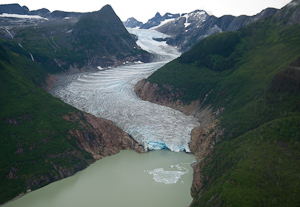
At the lodge we had an early lunch of king salmon cooked over alder and a very pleasant trail walk. After flying back we walked around Juneau a bit but the hoards of Carnival Cruise people again made it rather unpleasant. Then we were picked up by a woman who lives in Juneau and I had met at a music workshop, and she took us for a visit to the Mendenhall Glacier and tea at her home. Finally, a meal at a Chinese restaurant (pretty bad, but what can you expect here?) followed by packing and early to bed for a 6:00 AM airport shuttle and then an uneventful flight back to home, and work, and "real life."
These are the critters we saw:
Grizzly bear (brown bear) with cub
Moose
Wolves with cubs
Dall's sheep
Caribou
Bald eagle
Golden eagle
Stellar sea lion
Harbor seal
Dall's porpoise
Marbled murrelet
Ring-necked kingfisher
Pigeon guillemot
Beaver
Humpback whale
Orca
Tufted puffin
Horned puffin
Varied thrush
Red squirrel
Trumpeter swan
Mountain goat
Pelagic cormorant
Black legged kittiwake
Porcupine